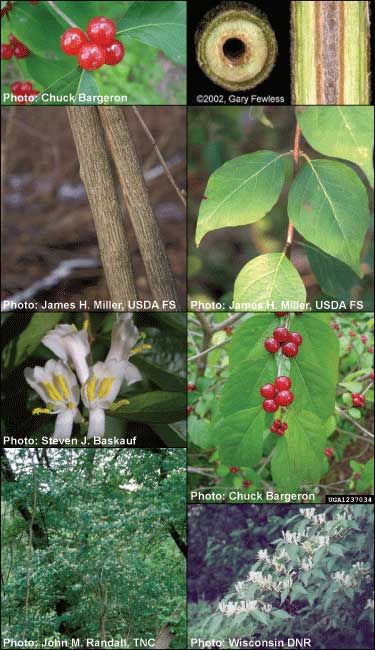|
Honeysuckles (Lonicera spp.)
What problems do invasive honeysuckles cause? Like most invasive plants on the Top 12 list for Northwest Michigan, invasive honeysuckles replace native plants in high quality natural areas, which in turn reduces critical food resources for birds, butterflies, and other wild creatures. Invasive honeysuckles in particular affect native ecosystems by throwing off the balance. While their flowers do provide nectar to birds and pollinating insects and the berries are food for birds and small mammals, the foliage is unpalatable to most native insects. Songbirds especially rely on insect feed for their young to survive the growing season. What do invasive honeysuckles look like? Invasive honeysuckles are often upright, spreading shrubs between 6 and 16 feet tall, though Japanese honeysuckle is a vine. A common feature for all honeysuckles (including natives) is their paired leaves and showy flowers; however, invasive honeysuckles have flowers—and therefore fruits—all along the younger twigs , while native honeysuckles bear their flowers and fruits at twig tips, backed by leaves joined to form a “dish.” Additionally, invasive honeysuckles have hollow stems (especially on older branches). Leaf shape for invasive honeysuckles varies from round ovals with long pointed tips to longer “flat” ovals to nearly triangle-shaped. How do I manage invasive honeysuckles? Preventing invasive honeysuckle from entering our natural areas by planting landscape alternatives is the first step in successful management; explore native alternatives to attract birds and pollinators. The native honeysuckles -- limber (L. dioica) and trumpet honeysuckle (L. sempervirens) -- make excellent choices when a vine is appropriate in your landscape. For shrubs, try flowering native shrubs and small trees like red elderberry, fly honeysuckle, and flowering dogwood. Prevent further invasions by restoring degraded areas like forest edges or roadsides back to native shrubs to prevent invasive plants from forming monocultures by increasing resource competition. If you’re managing existing invasive honeysuckle populations, develop a management plan that includes surveys so you can ensure you’re effectively prioritizing control efforts. Invasive honeysuckle populations can be effectively lowered through cutting stems and digging up roots; if roots are left, applications of herbicide are helpful to ensure root death and prevent resprouting. |
| habitatmatters.org |
Contact US231-252-4148
3334 Veterans Drive Unit A Traverse City, Michigan 49685 |
Pleasant Peninsula Design, Habitat Matters 2017


